Pruning Conifers
Early winter pruning of feathery conifer growth
For us careful pruning is a way of keeping our plants looking pleasing, healthy and in a nice proportion with their neighbours. Careful pruning is also a way of extending the life of a plant since a plant that has outgrown its space or caused excessive damage to another plant might mean that plant, or the neighbouring plant, would have to be removed!
Careful pruning is also good and healthy for us! Using a stepladder on sloping ground can be hazardous and therefore we prefer to decide what height would best for us and the plant rather than let the plant always make the decision!
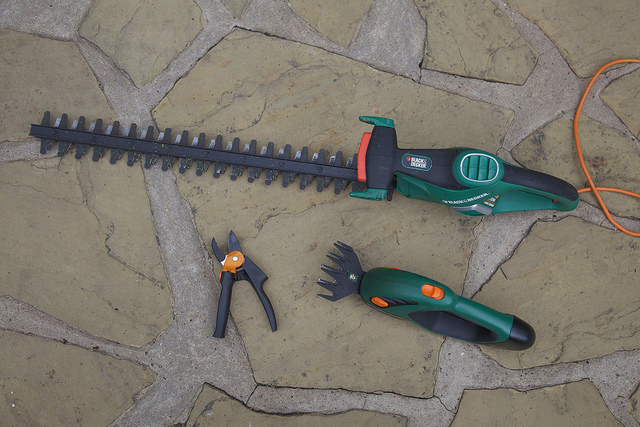
Our way of pruning a very overgrown conifer:
If we had an overgrown conifer and we wanted to restore it to a smaller size, we would do it our own way and we will outline the stages that we would go through. It is not as complicated as it may read however you do need someone who is agile enough to safely do the higher cuts if it is a tall conifer! :
- Stand back and study the conifer and decide the intended eventual height and approximate shape. Most likely, as for most conifers, a somewhat conical shape will be chosen.
- If the woody growth of a conifer is cut during spring on summer it almost always will 'bleed' sap which is unsightly. At some time during the winter months, when the sap is no longer rising, choose a site on the trunk to lop off the top of the tree with a saw. Preferably the cut should be just above a branch or branches with some conifer foliage growing a moderate distance along the length of the branch(es). Hopefully, in due course, new growth from the nearby branch(es) or from the trunk itself will gradually hide the cut on the trunk. After lopping the top off the conifer tree it will almost certainly look a fairly ugly shape but do not worry about this.
- Next start shaping the branches which are left on the remainder of the tree trunk. With an intended cone shape in mind start at the top of the lopped tree and shorten the upper branches by the biggest proportion but always leave some living conifer foliage on the branch so that new growth can occur in the future from that branch. From time to time stand back and look from different angles to check how the new shape is developing. We find it best to try and angle the cuts so that the cut surface is hidden as much as possible from the normal garden viewing point.
- Whilst working on the new tree shape remove any obvious dead branches or brown bits which will not only make the tree look nicer but it will let more light in to reach the foliage and encourage new growth. Towards the end of the tree shaping process a slightly ugly gap remains but we sometimes find this can be improved by using a non damaging rope or cable, in an as aesthetic way as possible (we use a dark colour rope of cable) to internally pull a branch to close the gap. From the aesthetic point of view we sometimes use a brown paint to disguise any excessively visual cuts on the branches)
- Since the pruning has been performed in the winter there will be new growth in the next few months.
- During the next winter further shaping that need cuts into woody growth, can be done however if necessary minor tidy up pruning could be done at any time of the year.
- We have a saying “If in doubt…cut it out! (or chop it out!)” The main reason for saying this is that when looking at a plant that looks overgrown, almost certainly the plant is overgrown and the problem will look worse with time if nothing is done and quite possibly the whole plant would need to be removed if it is left to grow even more. In the past we used to worry that pruning or cutting a plant hard would kill it but almost never have we killed a plant this way and afterwards we have never regretted cutting anything hard. Usually new growth quickly occurs. Most conifers will not regenerate new growth from a branch which have been cut back to leave no foliage on the branch. Therefore it is probably important to repeat at this stage that for virtually all conifers, apart from some of the taxus/yew varieties, always leave some living conifer foliage on the cut branches that remain on the tree so that new growth can occur in the future from those branches.
- Our aim with all pruning whether minor or major, is to to make it look as if it has never been done! We can not always achieve this aim immediately but it is suprising how often it is achievable either immediately or after a period of minimal spring growth.
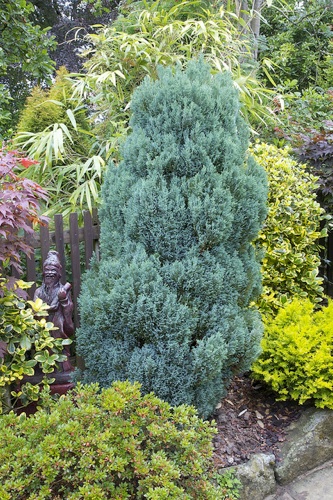
Chamaecyparis lawsoniana 'Ellwoodii' (Lawson false cypress)
Our 'Ellwoodii' was planted in 1992 and we maintain it to a height around 1.8 m. However, unpruned adult specimens could reach a height of about 4m and width 1.5m.
'Ellwoodii' is rather unusual in that its normal shape is due to upwardly-growing branches making multiple cone-shaped columns. This is our only 'wired' conifer. When pruning this conifer we have evolved a different technique than that used for our other conifers. Maintaining the cone shape and size of the conifer has been achieved by careful pruning of the columns.
Typically about once yearly we take out some of the older central columns and shorten some of the other columns angling the woody cuts so that they are not visible. Finally we use a fine garden wire, which is barely visible amongst the foliage, at two or three sites around the circumference of the conifer to gently gently pull it back to a compact shape.
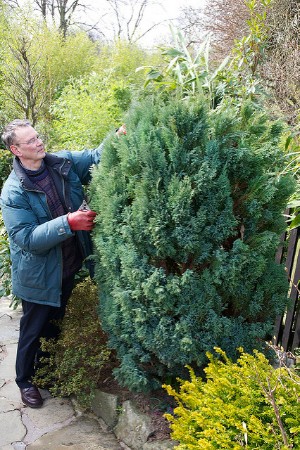
Major pruning of Chamaecyparis lawsoniana 'Ellwoodii'
In this photo Tony is looking very serious as he is deciding what to do! Some radical pruning is needed and it is also a great opportunity to make the conifer smaller!
This conifer was planted over 30 years ago. 'Ellwoodii' is rather unusual in that its normal shape is due to upwardly-growing branches making multiple cone-shaped columns. For many years maintaining the cone shape and size of the conifer has been successfully achieved by careful pruning of the columns once every year or two.
However, the upwardly-growing branches of the Ellwoodii are more prone to snow damage than most conifers. After several heavy snow falls in recent months it has become untidy.
Not only that, in recent years, despite regular minor pruning, the conifer had slowly become slightly larger than we wanteder.
.
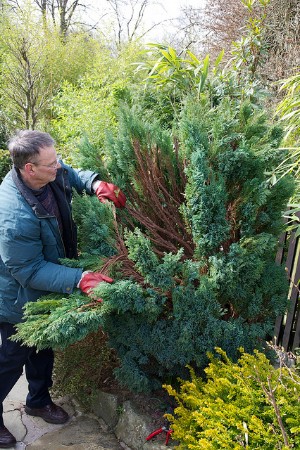
Major pruning of Chamaecyparis lawsoniana 'Ellwoodii' conifer.
Assessing which older central woody columns to remove and which ones to shorten.
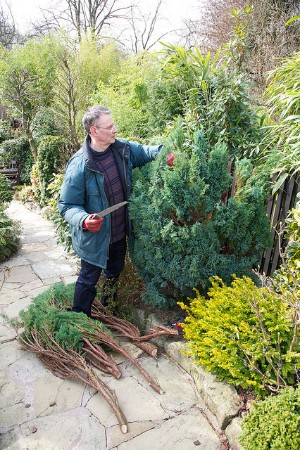
Keeping a vision of the intended final shape and size after pruning, Tony taking out some of the older central columns and shortening some of the other columns. The plan also included making the woody cuts so that they would not be outwardly visible when all the pruning process was completed.
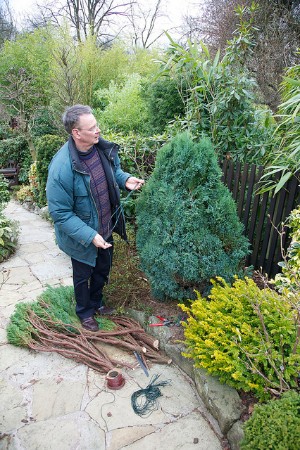
Finally we use a fine garden wire, which is barely visible amongst the foliage, at two or three sites around the circumference of the conifer to gently gently pull it back to a compact cone shape.
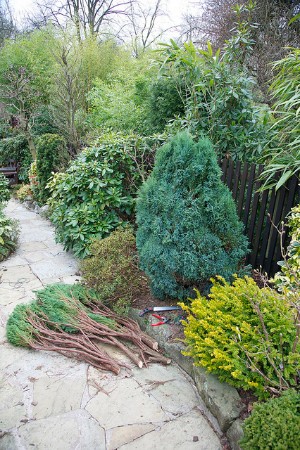
Major pruning of Chamaecyparis lawsoniana 'Ellwoodii' conifer completed
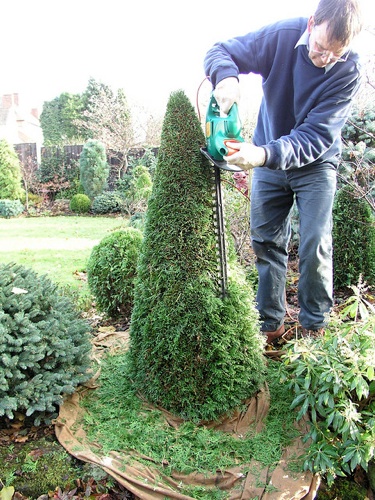
Thuja occidentalis 'Smaragd' (White cedar 'Smaragd' / Emerald green cedar)
This conifer has a naturally upright and tight growing habit and has inconspicuous shaggy red bark. It has dense, evergreen foliage held in vertical sprays and with a relatively fine texture. The scale-like leaves remain emerald green through the winter. It is hardy and very amenable to pruning.
Without pruning, will grow at a slow rate to about 12 feet tall at maturity, with a spread of 4 feet. It tends to fill out right to the ground.
I am using an electric hedge cutter in this image however, usually my preference is to prune our Thuja occidentalis 'Smaragd' conifers using secateurs in order to enhance their texture and beauty.....but it does take longer than using an electric hedgecutter!
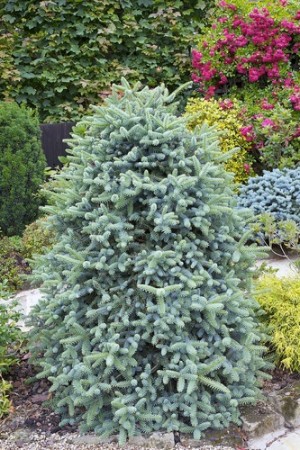
Abies pinsapo 'Aurea' (Spanish fir)
This conifer could grow to 7 metres; however, we maintain ours to around 1.5m and keep it to an enhanced conical shape. We mean that the conifer naturally grows to an approximate cone shape but we tidy it to a more definite cone shape by selective pruning during winter. It will put on about 15cm (6in) of new growth per year (as in this photo).
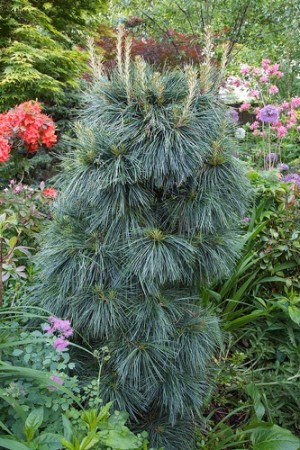
Pinus wallichiana 'Nana' (Dwarf Himalayan Pine, Butan Pine)
We like the long needles of this decorative pine and many of our visitors also mention how delightful they are to see it and to touch it! The needles around 5 inches long and in fascicles(whorls) of five. They are three-sided, blue on the two upper sides and green and smooth on the lower, creating a very soft, silvery-blue appearance.
The new late spring growth shoots of our plant would increase the height by about 8 inches per year and the width by about 12 inches each year. In order to keep the plant to a small size, in late spring we cut off about 4/5 of the length of the soft leggy new growth shoots which quickly heal. Sap loss is minimal, barely visible and quickly ceases. By late summer the remaining new needles have fully lengthened, the plant looks compact and there is no clear visible sign that pruning has been done.
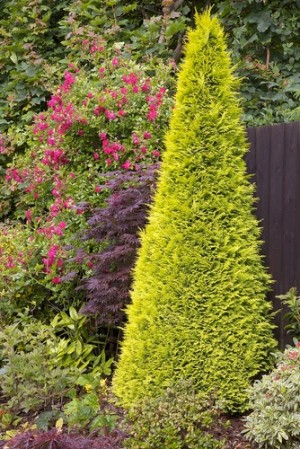
Chamaecyparis lawsoniana 'Golden Wonder'
'Golden Wonder' is a conifer which has bright golden-yellow foliage that maintains good colour throughout the year. It looks even more stunning when contrasted against other colours such as shades of red or blue.
The 'Golden Wonder' could ultimately reach 12 metres in height. However we have maintained ours to a height around 2 metres!
The conifer in the photo was planted in 1990 and since then we have shaped it with secateurs before maintaining it to the same size in recent years by occasional electric ‘hedgecutter clipping’. We now lightly clip the foliage once a year, usually in June or July, after the prolonged surge of feathery new growth in spring has started to look untidy. Within a month of the clipping, extra new growth appears and there is a nice, generalised, golden-green ‘glow’ which will last until the surge of bright feathery new spring growth in the next year.
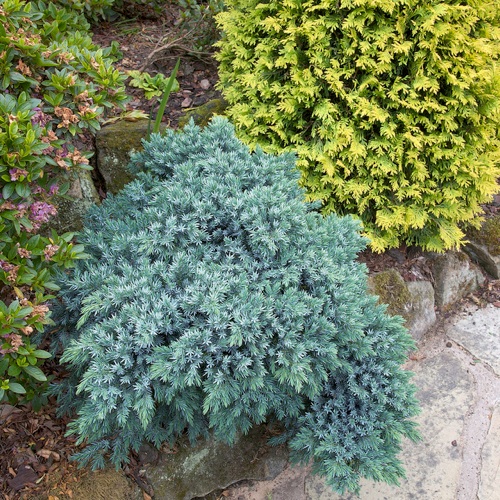
Juniperus squamata 'Blue Star'
Planted 19 years ago and kept to size by occasional careful pruning this Juniperus squamata 'Blue Star' is a beautiful compact slow growing dwarf conifer with steel-blue coloured foliage.
The plant forms a slightly craggy rounded shape with tight packed stiff prickly needle-like foliage giving it a very distinctive texture.
In the absence of pruning its 10 years size is only likely to reach around than 50cm in width and 30 cm in height, and at 20 years width 1m and 50cm height.
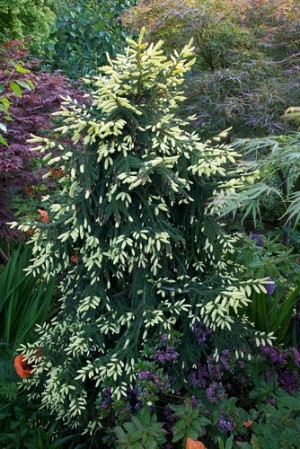
Picea Orientalis 'Aurea Spicata' (Aurea Oriental spruce)
In late spring and early summer this lovely conifer has golden-yellow new growth contrasting beautifully with the older green foliage. It has an elegant shape due to the slightly drooping branchlets with short, blunt-tipped needles which are closely-packed.
A mature tree could reach 20m in height however we planted this tree in 1994 and we keep it to around 2m by pruning to shape and form once per year.

Pinus sylvestris "Glauca Fastigiata" Sentinel Pine, Columnar Blue Scotch Pine
A lovely columnar form of Scots Pine which is tight in habit. The long, twisted blue needles are more blue-green when young.
We planted this pine in 1992 and maintain it to a height of less than 2m however unpruned the mature height can reach 5-10m. When pruning we only shorten the new growth of the current season or remove or loosely tie back any straggling branches, for example after a rare heavy snowfall.
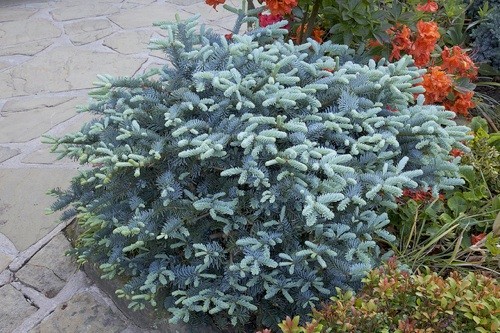
Abies procera 'Glauca Prostrata' Formerly Abies magnifica 'Prostrata'
A low spreading steely-blue conifer with prostrate branches. A cultivar of the Noble Fir, it grows slowly but would grow to 1.5m across in 10 years without pruning Most winters we lightly prune to keep it to size and, in particular to maintain its prostrate form, we remove any upright leaders which it occasionally produces.
This abies apparently needs moist conditions and protection from drying winds; however, ours is in full sun and always seems to look tidy! Like other of our abies cultivars it has significant ability to produce new growth from 'old' wood.

Blue Atlas Cedar (Cedrus atlantica Glauca)
It is likely that a Blue Atlas Cedar Atlantica would quickly become too large for an ordinary garden and most would need removing 10-15 years after planting! At full maturity it could reach a height of 30–40 m (around 100ft), with a trunk diameter of 1.5–2 m (4-6ft)!
However, we planted this blue cedar in 1993 and have kept it to the height and shape by regular pruning. In this picture it has a height of 2.5m (8ft) and we have no intention of letting it outgrow its present space!
This cedar variety is native to North Africa's Atlas Mountains and is often considered to be one of the most dramatic of all large blue conifers. In parkland planting it is often a magnificent, large, specimen evergreen conifer with elegant wide spreading branches. It has silver foliage, the needles becoming blue with age.
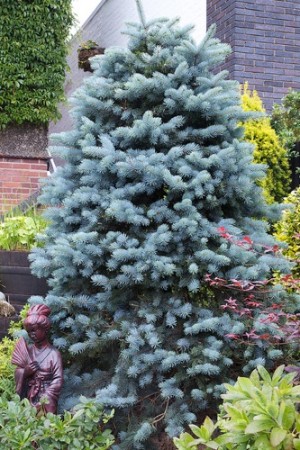
Picea pungens 'glauca group' Colorado spruce
Regarding Picea pungens we have three different cultivars in our garden which are all very similar and these are 'Hoopsii', 'Thompson' and 'Kosteri' and we are not certain which cultivar is which!
Although Colorado spruce originates in the Rocky Mountains of Canada and the USA it has been in wide cultivation in Europe and its colder regions. It is hardy to about -40°C! Spruce like neutral to slightly acidic soil relatively well drained soil and full sun.
It forms a neatly shaped tree with rich branching from the ground. It has relatively slow growth but could eventually reach 10m or more without pruning! Luckily picea pungens responds well to once yearly gentle winter pruning and, despite planting in 1992, we have kept ours to a height of about 2m.
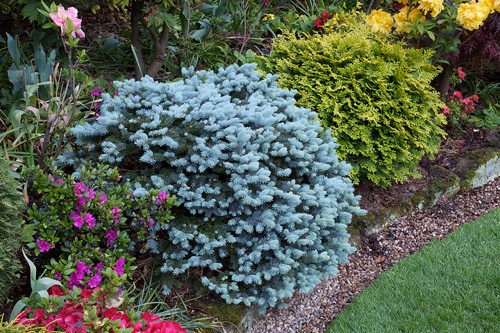
Picea pungens "Glauca Globosa"Dwarf Colorado spruce
Glauca Globosa is one of its many varieties sought after for its steel-blue, prickly needles. Although Colorado spruce originates in the Rocky Mountains of Canada and the USA it has been in wide cultivation in Europe and its colder regions. This spruce likes neutral to slightly acidic soil and full sun and is hardy to about -40°C!
The plant makes beautiful tiered branches that predominantly spread to the sides. Its ultimate height would be about 1.5m in maturity, however although we planted the picea in this picture in 1992 we have kept it to a relatively small size by once yearly gentle winter pruning.
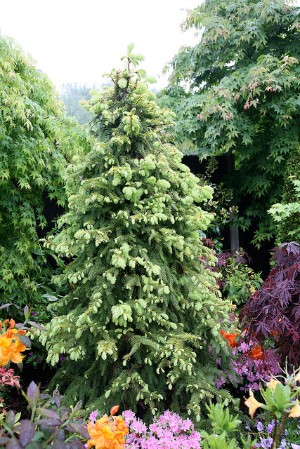
Picea abies 'Aurea Magnifica' (Magnificent Golden Norway Spruce)
We planted this conifer, which is one of the Norway spruce cultivars, in 1993 when it was about 1m in height. We allowed it to grow to 2m and for the last few years have kept it to the same height and width by careful once yearly pruning at the end of autumn.
If growth was left unchecked it might easily reach an eventual height of about 10m and spread of about 4m in 20-30 years which would be too much for neighbouring plants and the space available In our garden!
Four Seasons Sitemap
© All Rights Reserved
Please do not download our photo images from this website to use for publication or any commercial reason without our permission.
Images may not be copied, reproduced, published or distributed in any medium without the expressed written permission of the copyright holder.
